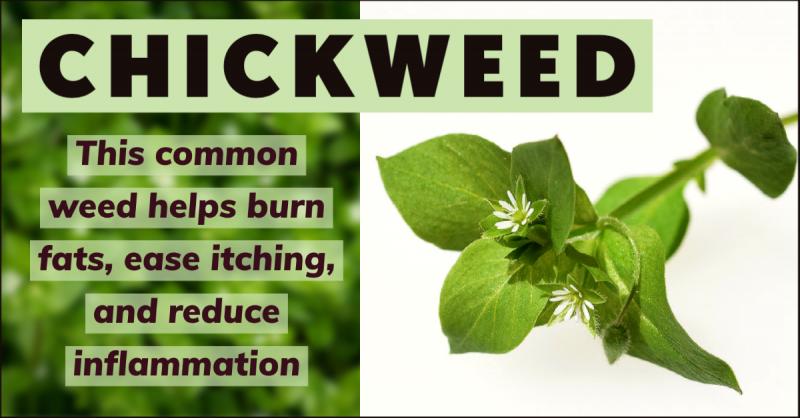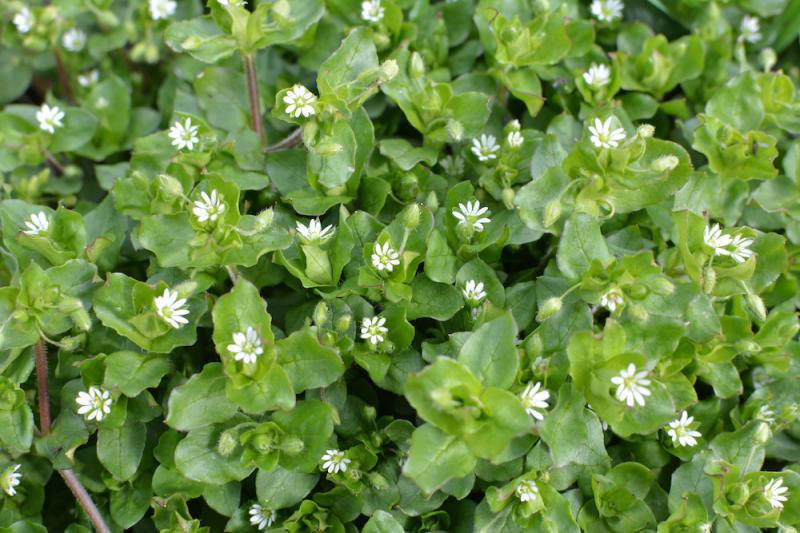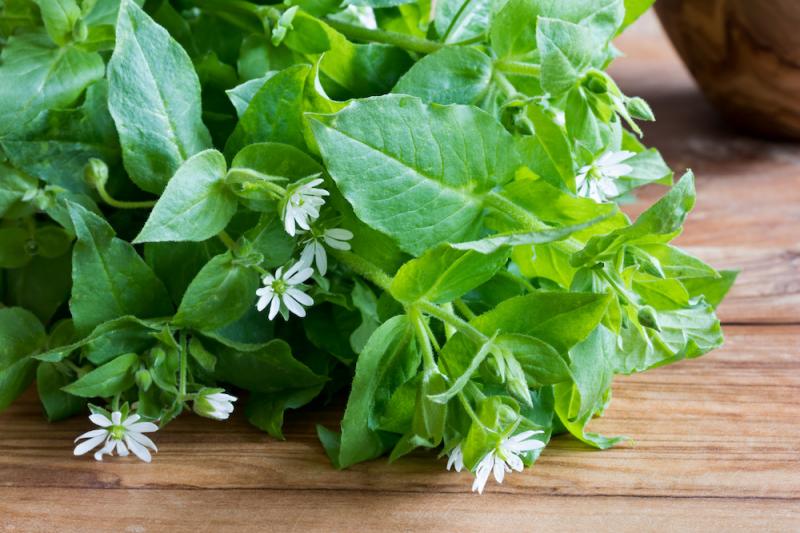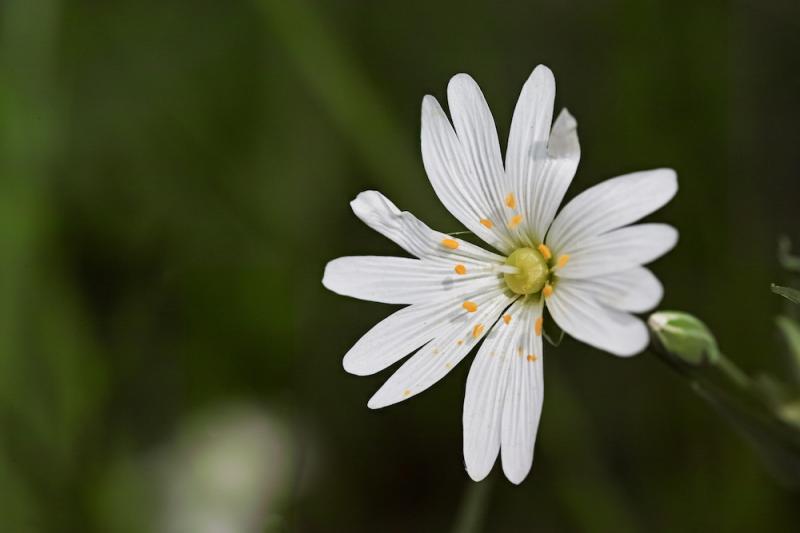
Chickweed is one of those weedy plants that’s easy to overlook, yet is both edible and medicinal. It’s found in moist places typically near woods. When I’ve seen it in Utah it’s typically been growing around trees in more moist areas of the Western forests. This herb is not only edible as a food, it’s also a versatile remedy for a wide range of health problems.
Chickweed and Fatty Deposits
 One of the primary uses I’ve made of chickweed is to help get rid of fatty deposits of all kinds, from fatty tumors (lipomas) to fatty liver disease. It is best used along with alterative herbs like burdock, gotu kola, dandelion, and black walnut for this purpose. These herbs will also break up watery cysts.
One of the primary uses I’ve made of chickweed is to help get rid of fatty deposits of all kinds, from fatty tumors (lipomas) to fatty liver disease. It is best used along with alterative herbs like burdock, gotu kola, dandelion, and black walnut for this purpose. These herbs will also break up watery cysts.
I’m not sure exactly why chickweed does this, but there is research suggesting it improves fat metabolism. It reduces triglyceride and LDL cholesterol levels and has been shown to have an anti-obesity effect. While chickweed alone won’t make you lose weight, it can help your body burn up fatty deposits more quickly as part of an overall program.
Chickweed and the Skin
 Chickweed has anti-inflammatory and vulnerary properties. It has been used as a poultice for any type of inflamed skin disease, including rashes, eczema, and burns. It also helps heal wounds and get rid of abscesses. It is also used as part of a salve or lotion to relieve itchy skin.
Chickweed has anti-inflammatory and vulnerary properties. It has been used as a poultice for any type of inflamed skin disease, including rashes, eczema, and burns. It also helps heal wounds and get rid of abscesses. It is also used as part of a salve or lotion to relieve itchy skin.
Years ago, a gifted chiropractor I used to go to, told me that itching is caused because there are fat-soluble toxins trapped just under the skin which the body is trying to eliminate through the sebaceous glands. The urge to scratch is to try to open up the skin to eliminate these toxins.
I believe this to be essentially accurate, which is one reason why I’ve found clay baths very helpful for itchy skin. I wrote about clay baths in The Healing Power of Clay. The clay pulls the fats and toxins out of the skin. Chickweed, by helping to emulsify or break up the fats would also make it easier for the toxins to escape the skin.
Reducing Inflammation and Dryness
 Taken internally, chickweed can aid any condition where there tends to be heat and dryness. It soothes, moistens, and nourishes tissues. This includes respiratory problems like a dry and irritated cough, bronchitis, asthma, and pleurisy. It also includes inflammation in the gastrointestinal tract including mouth sores, sore throat, colitis, and hemorrhoids. It can also be helpful for arthritis and mastitis.
Taken internally, chickweed can aid any condition where there tends to be heat and dryness. It soothes, moistens, and nourishes tissues. This includes respiratory problems like a dry and irritated cough, bronchitis, asthma, and pleurisy. It also includes inflammation in the gastrointestinal tract including mouth sores, sore throat, colitis, and hemorrhoids. It can also be helpful for arthritis and mastitis.
The young leaves of chickweed are edible as a salad green and have a mild, pleasant flavor. Being a nutritive herb, they are a very safe remedy for people of all ages. In fact, the common name arises from its use as an animal feed, especially for chickens, who apparently like the plant.
Chickweed is widely available in capsule or tincture form. It is also found in salves and lotions, formulas for excessive appetite and weight loss, alterative formulas, and because it is a rich source of iron, in herbal iron or blood-building formulas.
Downloads
Steven's Articles
-

-
The Sensible Use of Caffeinated Herbs
Kola nuts, guarana, and yerba mate and other herbs…
-

-
The Health Benefits and Problems with Coffee
This popular caffeinated beverage can be beneficial…
October
-

-
Understanding Caffeine & Cellular Adaptation
Preserving the power of caffeine's buzz and the…
September
-

-
Horseradish
A pungent spice for aiding protein metabolism…
-

-
Banaba or Crepe Myrtle
A beautiful tree from Southeast Asia whose leaves…
August
-

-
Monkeyflowers
Flower essences to help see ourselves more clearly…
-

-
Mariposa Lilies
Strengthening the bond between mother and child…
-

-
The Noble Bay Leaf
A common kitchen herb for aiding digestion and…
-

-
Epimedium: Horny Goat Weed
A circulatory stimulant and kidney yang tonic…
July
-

-
The Medicinal and Nutritional Benefits of Apricots
A nutritious fruit and valuable medicinal seed for coughs
-

-
Dogwoods
Asian dogwood is used to stop excessive discharge,…
June
-

-
Neem: The Village Pharmacy
A popular Ayurvedic remedy for dental and immune…
-

-
Spilanthes: The Toothache Plant
A traditional remedy for teeth and gums, as well…
-

-
Forsythia
An anti-inflammatory, fever-reducing, and infection fighting herb
May
-

-
Buckwheat (Kashi)
A delicious, high protein, gluten-free, gut-healthy food

